Ditching Plastic? Paper-Packaging Market Says ‘Welcome!’
Brand owners are switching from plastic to paper packaging to become more sustainable. How is their choice affecting the paper-packaging market?
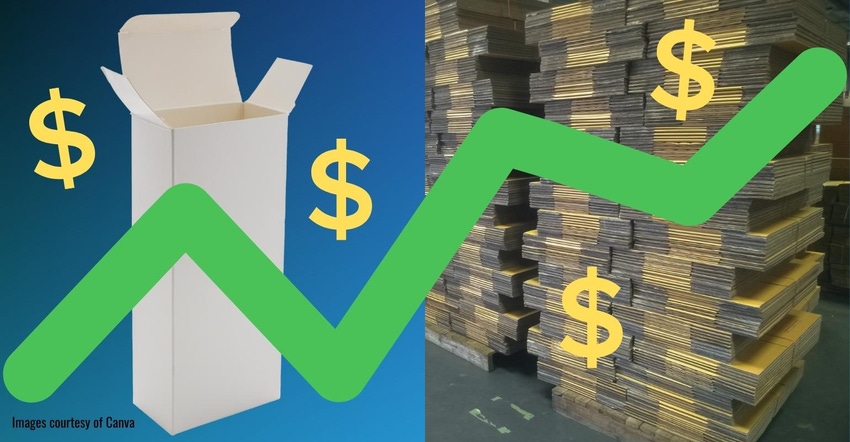
As more brand owners switch from plastic to paper-based packaging to boost sustainability, the paper-packaging market is changing. The moving parts include not only demand for paper packaging but also pandemic-related changes in consumer behavior and supply chain issues.
Consumer packaged goods (CPG) companies and their packaging suppliers are keeping an eye on those market dynamics and also on environmental issues such as climate change and wildfires, which could potentially affect raw material supplies needed for manufacturing paper packaging.
What are the drivers for today’s paper-packaging market?
Corporate sustainability goals are a primary motivator in the shift from plastic to paper. “All the major players in all the major CPG companies have some form of sustainability goals factored into their business model,” says Wayne Towle, sales manager at fiber-packaging supplier Planet Paper Box Group. “It is becoming more of a necessity for companies to do that.”
In the United Kingdom, Kellogg Europe recently tested paper liners, in place of plastic, for its iconic corn flakes. Kellogg has publicly stated its goal of using 100% reusable, recyclable, or compostable packaging by the end of 2025.
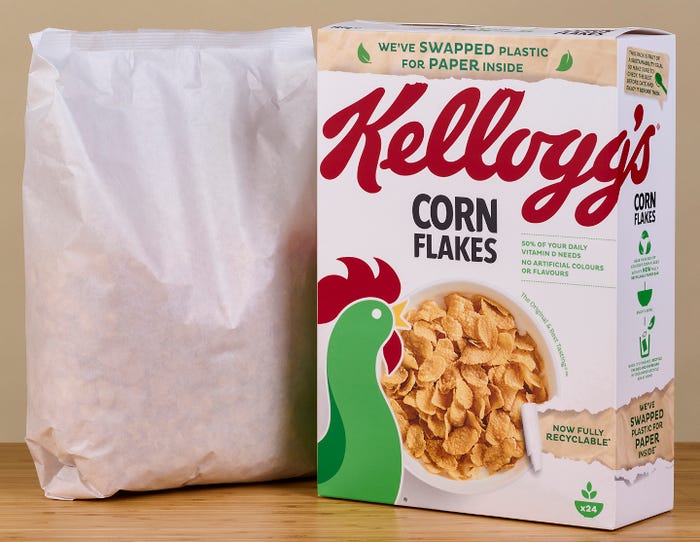
Also in the United Kingdom, PepsiCo is testing recyclable, paper-based outer packaging in place of plastic film for Walkers Baked potato crisp six-packs. The trial began on March 1, 2023. A few months earlier, the brand rolled out new paperboard outer packaging for 22- and 24-bag multipacks of the crisps.
PepsiCo has stated that by 2025 it will have designed 100% of its packaging to be recyclable, compostable, biodegradable, or reusable. Paper bottles may play a role: In 2020, PepsiCo began working with Pulpex to develop the world’s first recyclable paper bottle (developed initially by Diageo and Pilot Lite).
Retailers are also looking at paper packaging from new angles. “At Amazon, there are cases where we are switching from plastic to paper. For example, we created our recyclable paper-padded mailer to replace our mixed mailer that was unable to be curbside-recycled,” says Pat Lindner, VP of packaging innovation at Amazon.
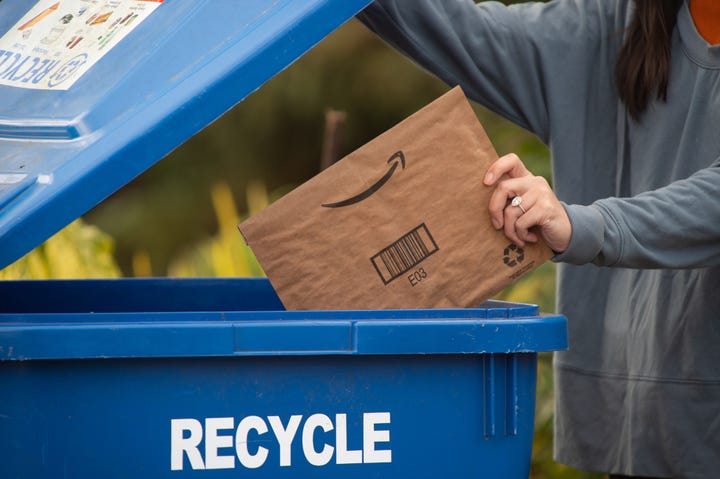
“We consider recyclability when it comes to selecting the right materials, but we also look at carbon and resources,” he adds.
Certified paper packaging: Supply and demand situation.
The content of paper packaging — specifically recycled fiber or virgin fiber from forests certified as responsibly or sustainably managed — is an important consideration for brand owners making the switch from plastic to paper.
Recent research from PMMI, the Association for Packaging and Processing Technologies, and the American Institute for Packaging and the Environment (AMERIPEN) indicates that CPG companies are increasingly interested in certified paperboard, including certified recycled.
The research results indicate that during the next 10 years, CPGs’ use of:
• Certified solid bleached sulphate (SBC) paperboard is expected to grow 34%.
• Certified kraft paperboard will grow 32%.
• Certified recycled paperboard will grow 24%.
• Certified corrugate will grow 21%.
Use of the noncertified analogs of these materials is forecast to shrink during the same period.
So is there enough certified fiber available to meet growing demand from CPGs?
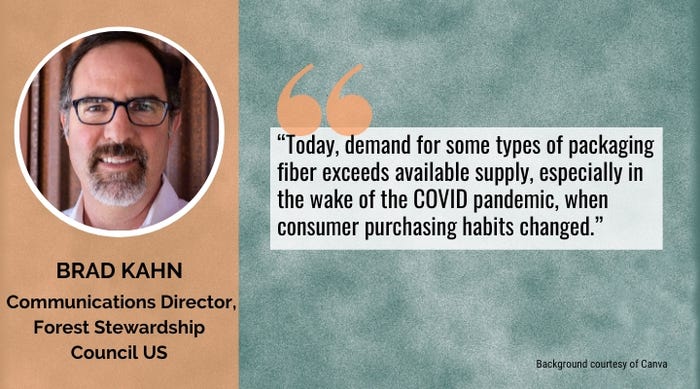
Forest Stewardship Council (FSC) certification, “is like any other sustainability strategy: It is best accomplished in partnership with suppliers by setting clear goals over a period of time. Today, demand for some types of packaging fiber exceeds available supply, especially in the wake of the COVID pandemic, when consumer purchasing habits changed,” says Brad Kahn, communications director at FSC US.
“At the same time, there are FSC-certified forest managers who would love to sell more certified fiber,” Kahn adds. “These sourcing relationships take time to develop but generally speaking, yes, there is enough fiber to meet current and growing demand.”
Certification and family forests.
Family-owned forests continue to play an important role in assuring adequate supply of certified paper products, and standards/certifying bodies are making it easier for those landowners to gain certification.
“Family woodlands represent the largest landowner class in the US. In some regions, such as the Southeast US, family forests represent the lion’s share of supply into mills,” says Kahn.
Statistics from the Congressional Research Service indicate that 61% of the 443 million acres of privately owned US forests are family owned.
To lower barriers to certification for these landowners, FSC operates a group certification program. “Groups typically share costs among group members and provide technical assistance to landowners. Leading pulp and paper companies manage groups to meet their needs for FSC-certified fiber,” Kahn says.
International Paper (IP) is working with FSC to streamline certification of small forests from which it sources wood, particularly those struggling with the administrative work required for forest certification.
“We recognize the administrative and financial challenges of certifying forests. To help landowners with the administrative burden, International Paper has started an internal Forest Stewardship Council forest certification management group. This group helps small private landowners who supply to IP [to] certify their forest lands while minimizing administrative burden,” says Jay Fowler, marketing director, North American Container, International Paper.

The Sustainable Forestry Initiative (SFI) takes a different tack with wood coming from small forest owners, putting the onus for sustainable forestry on the SFI-certified company buying the wood.
“About 60% of fiber in the US does come from small family forest landowners, people like me or you who may own five, 10, 1,000 acres of forest land,” says Jason Metnick, senior VP, customer affairs, at SFI. “Most likely, they’re not managing those lands for timber production. They’re managing it for other benefits,” but timber does come off those lands.
“Because SFI was developed in North America, we knew early on that the majority of fiber in the supply chain comes from these small landowners,” Metnick adds. “So what can we do to positively impact that larger landscape? That’s really where the benefit of the Fiber Sourcing Standard comes into play.”
Companies certified to the SFI Fiber Sourcing Standard must show that the raw material in their supply chain comes from legal, responsible sources. Third-party audits confirm the use of sustainable forestry practices.
Larger forestlands typically get certified to the SFI Forest Management Standard, the largest forest certification standard operating in North America.
SFI also collaborates with the American Tree Farm System to increase forest certification on family-held land.
Recycling, and recycled content.
Brand owners switching to paper packaging are interested in recycled content, as well as certified-sustainable materials. Among their concerns are the availability of recycled fiber and the need to strike a balance between recycled and virgin fiber in packaging materials.
“Wastepaper collection issues combined with global supply chain shortages and bottlenecks due to coronavirus and the Ukraine/Russia war have certainly had an impact on brand owners’ ability to access recycled fiber over the last few years,” says Charles Haverfield, CEO of US Packaging & Wrapping.
“However, it is not a lack of recycled-paper content so much as suppliers reducing product offerings … due to a lack of demand for certain products,” Haverfield adds.
The availability of recycled fiber depends on recycling infrastructure and capacity, as well as consumer behavior.
The availability of recycled fiber depends on recycling infrastructure and capacity, as well as consumer behavior. As more brand owners move “away from single-use to alternatives such as paper or corrugated, that [fiber] volume will now come back into the recycling stream,” says Towle, of Planet Paper Box.
“The question then becomes: Is there enough recycling infrastructure or recycling facilities to handle that volume and the amount of product?” Towle notes. Additionally, are consumers “disposing of paper packaging … in a respectful manner to ensure that the product can be recycled?”
According to the American Forest & Paper Association (AF&PA):
• In 2021, 94% of Americans had access to community paper recycling programs.
• The US paper recycling rate has met or exceeded 63% every year since 2009.
• The recycling rate for old corrugated containers (OCC) was 91.4% in 2021, and the three-year average leading up to 2021 was 90.5%.
• In 2021, 41.1% of paper recycled in the United States was made into containerboard, aka corrugated.
AF&PA also reports that about 80% of all US paper and paperboard mills used some recycled paper to manufacture new paper and paperboard products, including packaging, in 2021. One-third of the mills used only recycled paper.
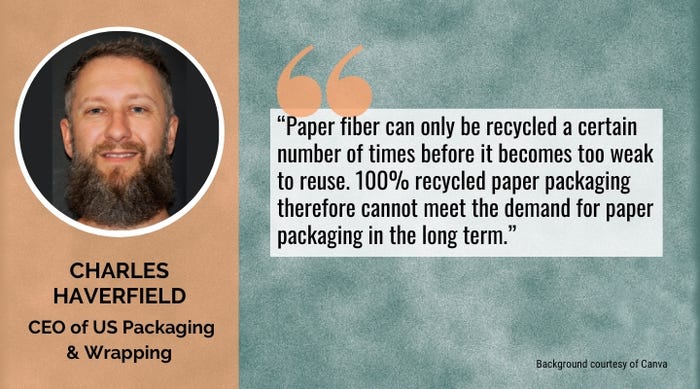
It’s important to note that “paper fiber can only be recycled a certain number of times before it becomes too weak to reuse. 100% recycled paper packaging therefore cannot meet the demand for paper packaging in the long term,” Haverfield says.
Combining recycled fiber with certified-sustainable virgin fiber can optimize the material’s strength and performance without sacrificing sustainability.
“Because fiber is not indefinitely recyclable, new fiber has to be introduced in the paper-making process to keep the process sustainable,” says IP’s Fowler.
“We take the time to educate our customers about both the health of US forest lands and the already very high corrugated recovery rate for recycling — greater than 90%. Requiring specific recycled content in corrugated can suboptimize an efficient raw material supply chain, causing unintended environmental and cost consequences,” Fowler adds.
To promote the use of recycled fiber, the US Environmental Protection Agency (EPA) has developed procurement guidelines for paper products, including packaging.
According to the guidelines, “Paperboard mills use more recovered fiber than any other segment of the paper industry to manufacture a wide variety of product packaging (folding cartons), beverage carriers, mailing tubes, industrial paperboard (cores, drums, tubes, and cans), and many other items.”
For corrugated containers, EPA recommends post-consumer recovered fiber levels of 25% to 50%, or 25% to 30%, depending on the container’s burst strength. The agency recommends 40% to 80% post-consumer fiber in folding cartons.
Potential affects of climate change on paper supply and the paper-packaging market.
As packagers move toward using more paper-based packaging — at a time when wildfires pose a greater threat to forests in North America and Europe — should they be concerned about climate change and wildfires affecting paper supply?
“While we’ve not seen any sign of wildfires affecting paper supply chains yet, there is no telling what could happen in the coming months, as we enter the height of fire season,” says Haverfield.
Towle points out “the question we need to ask is: Is this land forested land or protected land? A lot of the content we see on the news regarding fires may not be forested land but protected land, so from our perspective we do not see the drought or the wildfires affecting paper supply in any way.”
Recent data from the Congressional Research Service indicate there have been more than 61,410 wildfires per year in the United States since 2013, affecting 7.2 million acres of land annually, on average. In just the first two months of 2023, about 3,500 wildfires impacted 28,7000 acres in the United States. Wildfires don’t discriminate between government-owned and privately held land.
In addition to potentially affecting the supply of wood and pulp, wildfires cause “other rolling consequences to paper packaging supply chains,” Haverfield notes.
“Emergency evacuations to protect employees effectively puts a stop to all operations, while road blockages and transportation delays can set supply chains back weeks, if not months,” he adds. “And even as suppliers recover, customers that have also been affected by wildfires may take longer to bounce back.”
Fire and other climate-related issues are a pressing issue for responsible-forestry standards and certification organizations such as SFI and FSC, as well as forest managers and the paper-packaging supply chain.
Fire and other climate-related issues are a pressing issue for responsible-forestry standards and certification organizations such as SFI and FSC, as well as forest managers and the paper-packaging supply chain.
“As climate change impacts worsen, corporate commitments to action increase. In particular, the focus on nature-based solutions to climate change has increased dramatically over the past five years,” says FSC’s Kahn.
“Whether from small family forests or large industrial ownerships, companies are demanding ‘climate smart’ management that promotes resilience, conserves biodiversity, and protects other forest values,” he adds. “FSC remains the most trusted proxy for such management, and we’re seeing new interest every day. Every company uses forest products, so eventually they all look at the associated impacts.”
As for sustainable-forestry standards, SFI added two new climate-related objectives to its Forest Management Standard in 2022. One addresses climate change mitigation and adaptation. The other targets fire resilience and awareness.
Costs considerations.
Various factors, including higher demand for corrugated shippers to accommodate robust ecommerce sales, have played a role in recent price dynamics for paper-based packaging.
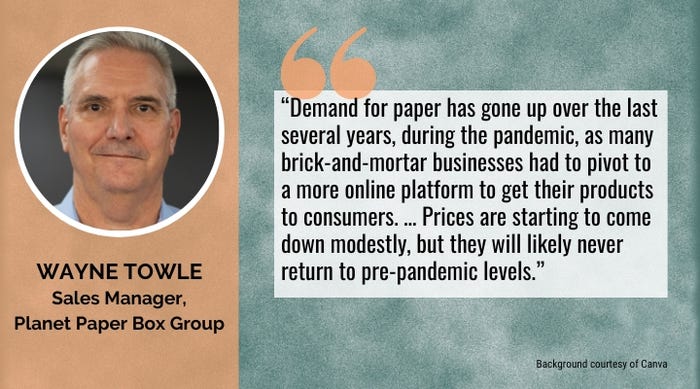
“Demand for paper has gone up over the last several years, during the pandemic, as many brick-and-mortar businesses had to pivot to a more online platform to get their products to consumers,” Towle says.
“That drove cost tremendously over the last two years in the corrugated industry,” he adds. “We have seen an increase of 30% in corrugated costs.” For coated recycled board (CRB), “the numbers are closer to a 26% increase. Prices are starting to come down modestly, but they will likely never return to pre-pandemic levels.”
Data from the Federal Reserve Bank of St. Louis show that commodity prices for pulp, paper, and allied products (packaging and industrial converting paper) rose between July 2020 and October 2021 and then fluctuated for nearly a year. Since August 2022, prices have dipped.
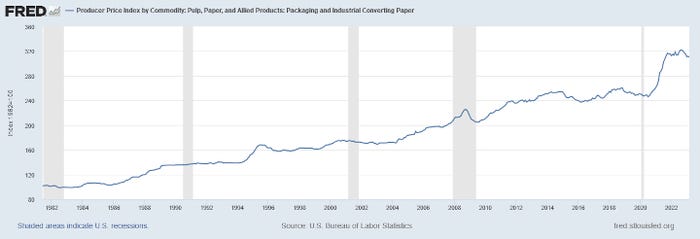
This supports Fastmarkets’ prognostication, in December 2022, that prices for packaging board and paper — particularly linerboard and corrugated sheets — in the US market were on the way down.
For brand owners and retailers, one tactic that may provide the dual benefit of improved sustainability and lower materials costs is to simply use less packaging.
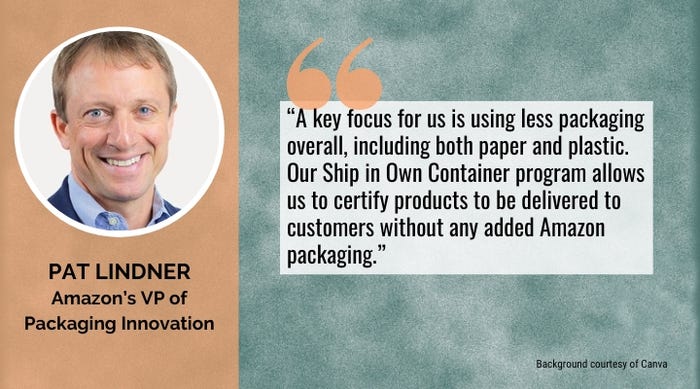
“A key focus for us is using less packaging overall, including both paper and plastic,” says Amazon’s Lindner. “Our Ship in Own Container program allows us to certify products to be delivered to customers without any added Amazon packaging.”
In 2022, more than 10% of Amazon’s packages were shipped without Amazon-applied packaging, and the company intends to boost that percentage.
Amazon also invests “in right-sized packaging through machine-learning algorithms and strive[s] to eliminate excess space when possible and pack products more efficiently,” Lindner says. “Since 2015, Amazon has reduced the weight of packaging per shipment by 38% and eliminated the use of more than 1.5 million tons of packaging materials.”
About the Author(s)
You May Also Like




